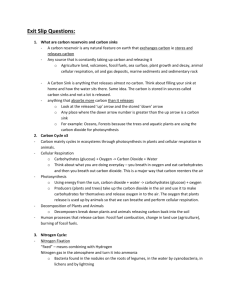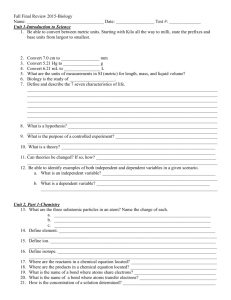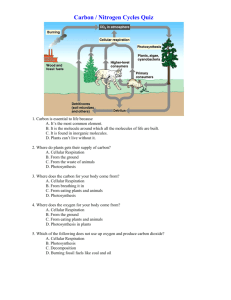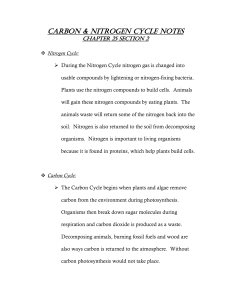File - WMLIS Science 10
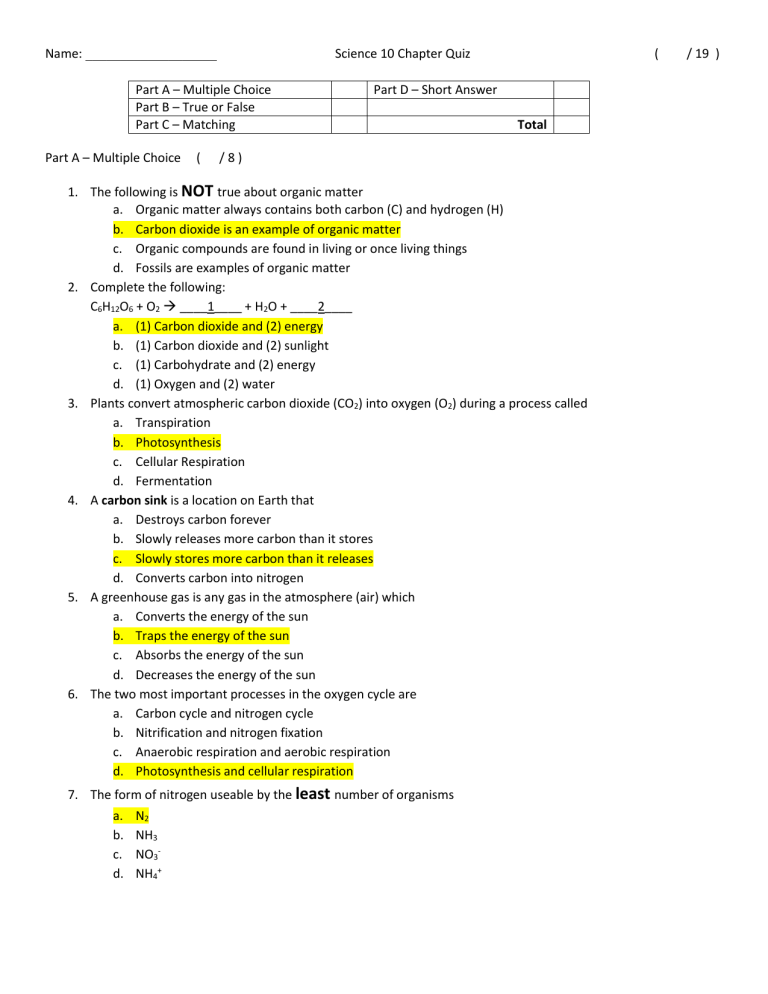
Name: ___________________
Part A – Multiple Choice
Part B – True or False
Part C – Matching
Science 10 Chapter Quiz
Part D – Short Answer
Part A – Multiple Choice ( / 8 )
1.
The following is
NOT
true about organic matter a.
Organic matter always contains both carbon (C) and hydrogen (H)
Total b.
Carbon dioxide is an example of organic matter c.
Organic compounds are found in living or once living things d.
Fossils are examples of organic matter
2.
Complete the following:
C
6
H
12
O
6
+ O
2
____1____ + H
2
O + ____2____ a.
(1) Carbon dioxide and (2) energy b.
(1) Carbon dioxide and (2) sunlight c.
(1) Carbohydrate and (2) energy d.
(1) Oxygen and (2) water
3.
Plants convert atmospheric carbon dioxide (CO
2
) into oxygen (O
2
) during a process called a.
Transpiration b.
Photosynthesis c.
Cellular Respiration d.
Fermentation
4.
A carbon sink is a location on Earth that a.
Destroys carbon forever b.
Slowly releases more carbon than it stores c.
Slowly stores more carbon than it releases d.
Converts carbon into nitrogen
5.
A greenhouse gas is any gas in the atmosphere (air) which a.
Converts the energy of the sun b.
Traps the energy of the sun c.
Absorbs the energy of the sun d.
Decreases the energy of the sun
6.
The two most important processes in the oxygen cycle are a.
Carbon cycle and nitrogen cycle b.
Nitrification and nitrogen fixation c.
Anaerobic respiration and aerobic respiration d.
Photosynthesis and cellular respiration
7.
The form of nitrogen useable by the
least
number of organisms a.
N
2 b.
NH
3 c.
NO
3
d.
NH
4
+
( / 19 )
8.
This is the process which returns nitrogen back to the atmosphere a.
Nitrogen fixation b.
Nitrification c.
Denitrification d.
Lightning
Part B – True or False ( / 3 )
9.
__F__ Decomposition of nitrogen compounds in dead animals returns nitrogen back to the atmosphere as N
2
10.
__F__ The root nodules of plants (legumes) contain bacteria which convert ammonium (NH
4
+ ) to nitrate (NO
3
)
11.
__T__ Carbon and nitrogen are both essential (needed) for all living organisms
Part C – Matching ( / 4 )
12.
__c__ Molecule which requires nitrogen to make
13.
__e__ Organic product of photosynthesis
14.
15.
__a__ Combustion of fossil fuels
__b__ Inorganic molecule a. Carbon Source b. Water (H
2
O) c. Nucleic Acid (DNA) d. Carbon Sink e. Carbohydrate
Part D – Short Answer ( / 4 )
16.
The two most important biological processes on Earth are photosynthesis and cellular respiration.
(1) Explain how these two processes are related. (1) Explain why they are so important to life on Earth.
You may use a diagram if necessary.
(0.5) Plants make O
2
, Animals make CO
2
(0.5) Cycle matter in between
(0.5) Plants use energy from the sun during photosynthesis
(0.5) Animals use energy from plants during cellular respiration
17.
Describe the steps taken by a molecule of diatomic nitrogen gas (N
2
) as it travels from the atmosphere (air) to the body of an animal.
(0.5) 1 Nitrogen fixation:
(0.5) 2 Nitrification:
N
2
NH
3
NH
4
+ NO
2
NO
3
-
(0.5) 3 Plants absorb nitrate (NO
3
) from soil to grow
NH
3
+ H
2
0 NH
4
+
(0.5) 4 Animals eat plants to gain nitrogen for protein and nucleic acid synthesis
